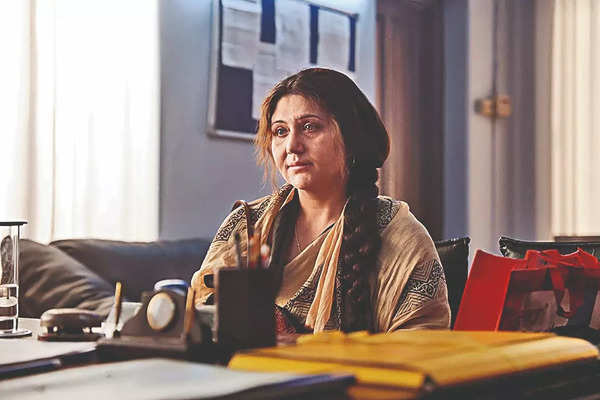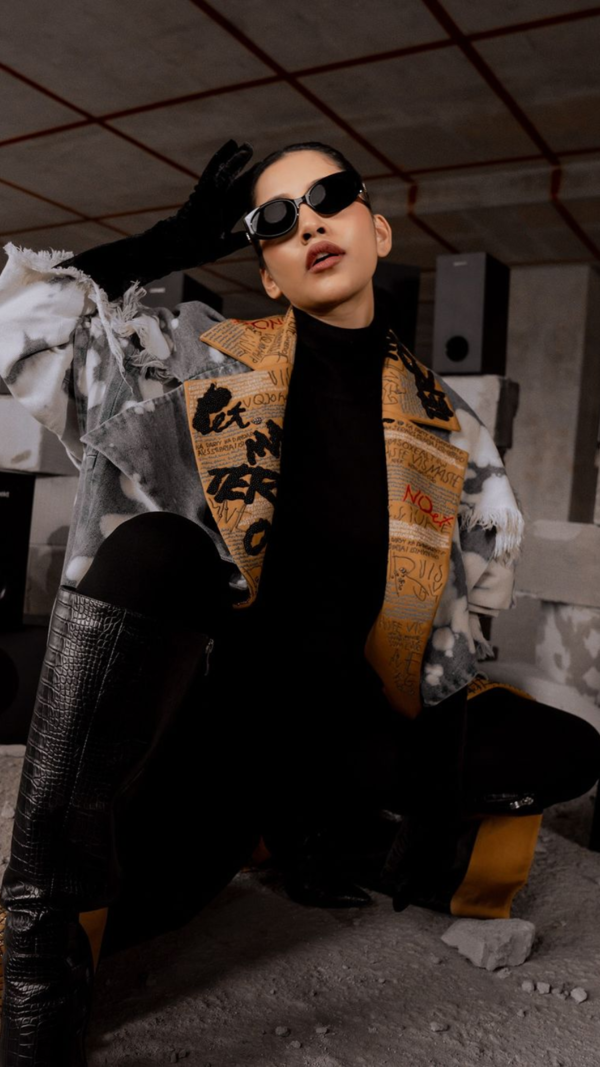- News
- entertainment
- bengali
- movies
- The trolling we face is also a kind of ragging: Swastika Mukherjee
Trending
The trolling we face is also a kind of ragging: Swastika Mukherjee
Swastika Mukherjee discusses the prevalent issue of ragging and her upcoming series Bijoya. She mentions facing trolling, challenges in her career, and her colleague Saayoni Ghosh's election win.

Swastika Mukherjee talks about an important issue like ragging, how ragging has become a racket, how she got ragged in her life, ways to combat bullying, her upcoming series and a lot more. Read on...
You were upset on voting day as your name was not on the voters’ list. Have you looked into it?
I was upset as voting is our democratic right. But I’m happy now that my friend and colleague Saayoni Ghosh won from our constituency.I’ve already had a word with our councillor and have sent all the necessary details. Hopefully it will get solved.
The series, Bijoya, where you play the titular character, is about ragging. Have you faced ragging in your student life?
And what about your workplace?
There have been innumerable incidents when I was removed from a film just a day ahead of the shoot. A dresser would come to my house to take away the costumes. Then there were circumstances where I knew I was doing a film but got to know from newspapers that some other heroine had replaced me! So, I have faced several such incidents in my life.

What is Bijoya all about? Tell us about your character.
Bijoya, a resilient woman from a small Bengal town, has single-handedly raised her son, Nilanjan, following her husband’s sudden death. Her dedication bears fruit when Nilanjan gains admission to a prestigious college in Kolkata, igniting hope for a promising future. Tragedy strikes when Nilanjan falls from the fifth-floor balcony of his hostel and slips into a coma. Rushing to Kolkata, Bijoya is met with heartbreak as her son battles for his life. Rejecting the police’s verdict of suicide, she embarks on an unwavering quest to uncover the truth. Her investigation reveals a sinister world of hazing, corruption, and powerful figures determined to silence her. The series will show Bijoya’s relentless pursuit to uncover the true cause of her son’s fall.
Despite numerous efforts to abolish ragging, bullying or teasing, it persists in our society. In your view, who holds the true responsibility for ragging – the institution or the individuals involved?
Both. Also, the anti-ragging cell members, police, administration – it is like a chain. For the raggers it’s a kind of power play. If you are ragging someone in a school or college there you want to show how much power you have. And if the victim is complaining to the anti-ragging cell, police or to the professors, they’ll say that they are under pressure from higher authorities, so they can’t help. So, this ‘pressure from higher authorities’ goes on and on and ultimately there’s no solution.

What motivated you to take on the role of Bijoya?
The incident that happened a year back involving a first-year student at a prestigious university devastated me. I felt that such stories should be told. A visual medium has more impact on people, and I felt this is an important story dealing with a predominant issue like ragging that should reach more people. As an artiste, I felt the character of Bijoya has a lot of power and sensitivity – as a mother fighting to get justice for her son. So, performance-wise, I had a lot of scope too. I think I can portray all characters well, but when it comes to playing a mother, I guess I do it in the best possible way.
What are three realisations you had while transforming from Swastika to Bijoya that you will remember for the rest of your life?
First, it is of utmost importance for parents to have extremely good communication with their children. Second, if your child is not willing to leave the city for education or for work, don’t force them. There are parents who dreamt of studying abroad but couldn’t, and now want their dreams to be fulfilled by their children. Refrain from doing that. And third, don’t ask your child to adjust, as life is not getting a seat on a crowded bus. I feel life itself is a compromise, so don’t burden your child any more with it.
How can students, faculty, and the broader community come together to eradicate ragging and create a safer environment?
Bhoy pele cholbena. That’s the first and foremost thing if you want to eradicate ragging. And one person can’t solve this age-old problem; society must unite against it. The anti-ragging cell must work without giving in to the so-called ‘pressure from above’ so that students can enjoy their life without any fear. I believe Bijoya is a brave work and it will make an impact on the society.
Quotes:

I’ve always told my daughter that whatever uncomfortable happens in her life, she must immediately share it with me and not hide it, as later, things might go out of hand
Ragging is all about power trips, manifestation of a perverted mind...all put together. There is an important dialogue in the series: ‘Bhoyer bapsar che boro bapsa kichu nai’. It’s the truth of our society
No consolation is enough for a mother who has lost a child. It’s a major battle for the family of a ragging victim to get justice. Sadly, our society always tries to pin blame on the victims
Pix: Rajarshi Mukhopadhyay
You were upset on voting day as your name was not on the voters’ list. Have you looked into it?
I was upset as voting is our democratic right. But I’m happy now that my friend and colleague Saayoni Ghosh won from our constituency.I’ve already had a word with our councillor and have sent all the necessary details. Hopefully it will get solved.
The series, Bijoya, where you play the titular character, is about ragging. Have you faced ragging in your student life?
Don’t you think we all are getting ragged every day in some way or the other? After the election results were declared, I posted a picture with Saayoni, and people started trolling me. The same happened when I posted a picture with Dev. This is also a kind of ragging. Thankfully, I never got ragged in school or college, but I had problems with teachers at times.
And what about your workplace?
There have been innumerable incidents when I was removed from a film just a day ahead of the shoot. A dresser would come to my house to take away the costumes. Then there were circumstances where I knew I was doing a film but got to know from newspapers that some other heroine had replaced me! So, I have faced several such incidents in my life.

Swastika Mukherjee in a still from Bijoya
What is Bijoya all about? Tell us about your character.
Bijoya, a resilient woman from a small Bengal town, has single-handedly raised her son, Nilanjan, following her husband’s sudden death. Her dedication bears fruit when Nilanjan gains admission to a prestigious college in Kolkata, igniting hope for a promising future. Tragedy strikes when Nilanjan falls from the fifth-floor balcony of his hostel and slips into a coma. Rushing to Kolkata, Bijoya is met with heartbreak as her son battles for his life. Rejecting the police’s verdict of suicide, she embarks on an unwavering quest to uncover the truth. Her investigation reveals a sinister world of hazing, corruption, and powerful figures determined to silence her. The series will show Bijoya’s relentless pursuit to uncover the true cause of her son’s fall.
Despite numerous efforts to abolish ragging, bullying or teasing, it persists in our society. In your view, who holds the true responsibility for ragging – the institution or the individuals involved?
Both. Also, the anti-ragging cell members, police, administration – it is like a chain. For the raggers it’s a kind of power play. If you are ragging someone in a school or college there you want to show how much power you have. And if the victim is complaining to the anti-ragging cell, police or to the professors, they’ll say that they are under pressure from higher authorities, so they can’t help. So, this ‘pressure from higher authorities’ goes on and on and ultimately there’s no solution.

What motivated you to take on the role of Bijoya?
The incident that happened a year back involving a first-year student at a prestigious university devastated me. I felt that such stories should be told. A visual medium has more impact on people, and I felt this is an important story dealing with a predominant issue like ragging that should reach more people. As an artiste, I felt the character of Bijoya has a lot of power and sensitivity – as a mother fighting to get justice for her son. So, performance-wise, I had a lot of scope too. I think I can portray all characters well, but when it comes to playing a mother, I guess I do it in the best possible way.
What are three realisations you had while transforming from Swastika to Bijoya that you will remember for the rest of your life?
First, it is of utmost importance for parents to have extremely good communication with their children. Second, if your child is not willing to leave the city for education or for work, don’t force them. There are parents who dreamt of studying abroad but couldn’t, and now want their dreams to be fulfilled by their children. Refrain from doing that. And third, don’t ask your child to adjust, as life is not getting a seat on a crowded bus. I feel life itself is a compromise, so don’t burden your child any more with it.
How can students, faculty, and the broader community come together to eradicate ragging and create a safer environment?
Bhoy pele cholbena. That’s the first and foremost thing if you want to eradicate ragging. And one person can’t solve this age-old problem; society must unite against it. The anti-ragging cell must work without giving in to the so-called ‘pressure from above’ so that students can enjoy their life without any fear. I believe Bijoya is a brave work and it will make an impact on the society.
Quotes:

I’ve always told my daughter that whatever uncomfortable happens in her life, she must immediately share it with me and not hide it, as later, things might go out of hand
Ragging is all about power trips, manifestation of a perverted mind...all put together. There is an important dialogue in the series: ‘Bhoyer bapsar che boro bapsa kichu nai’. It’s the truth of our society
No consolation is enough for a mother who has lost a child. It’s a major battle for the family of a ragging victim to get justice. Sadly, our society always tries to pin blame on the victims
Pix: Rajarshi Mukhopadhyay
End of Article
FOLLOW US ON SOCIAL MEDIA








